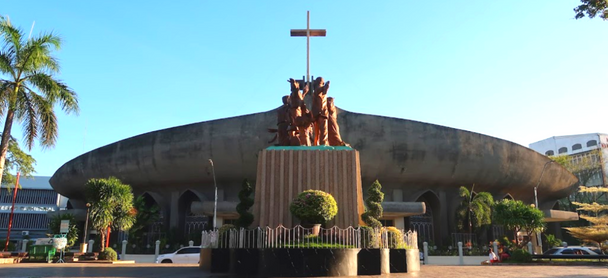
The Archdiocese of Davao covers Davao City, and the islands of Samal and Talicud of the province of Davao del Norte. Under its jurisdiction are the suffragan dioceses of Digos, Tagum, and Mati. The territory covers a land area of 2,443 square kilometers and is divided into two cities and three congressional districts under the country's Region XI (Davao Region). Davao City is also one of several cities in the Philippines that are independent of any province though it is usually grouped with Davao del Sur for statistical purposes. Davao's titular patron is St. Peter the Apostle, whose feast is celebrated June 29.
In 2016, the archdiocese's total population of 1,747,000 is made up of native Davaoenos (people of Davao),
The archdiocese had its beginnings in the 19th century thanks to three missionary groups. The Recollect Fathers came in 1848 and stayed until 1858. The following years saw the Jesuits step into the lush forests of Davao. Then, in 1937, upon the request of the Bishop of Zamboanga, the Priests of the Foreign Mission Society of Quebec (PME Fathers) came to Davao.
Davao City used to be the capital of the entire Davao Province until it became a chartered city in 1937. Three decades later, Davao was subdivided into three independent provinces -- Davao del Norte with Tagum as its capital, Davao del Sur with Digos as capital, and Davao Oriental with Mati as capital.
In 1967 the province of Davao was subdivided into three: Davao del Norte, Davao del Sur and Davao Oriental.
Davao City lies on the eastern edge of the province facing the Davao Gulf which opens out to the Celebes Sea. Although Davao City is no longer the capital of what used to be the entire Davao province, it has remained a principal commercial center for all the Davao provinces and the eastern and southeastern sections of Mindanao. In land area it is among the biggest cities in the world. It is populated mostly by migrants and is involved actively in inter-island as well as foreign shipping. Its beaches, and the Aguinaldo Pearl Farm, have become tourist attractions.
The PME Fathers were entrusted with spiritual care of the faithful in the areas included within the limits of Davao City and the present three provinces of Davao del Norte, Davao de Sur and Davao Oriental.
On Dec. 17, 1949, the Holy See raised the Davao Mission to the rank of Prelature "Nullius" of Davao. Subsequently, Archbishop Clovis Thibauld, PME, was elected its first Prelate Ordinary.
In 1958, Davao Oriental and Davao del Norte were given to the pastoral care of the Maryknoll Fathers. The city of Davao del Sur and two municipalities of Davao del Norte composed the present Archdiocese of Davao.
On July 11, 1966, the Prelature of Davao was elevated into a diocese, and Archbishop Thibauld took canonical possession of the Diocese of Davao as its first bishop.
On March 24, 1967, Archbishop Juan Nilmar took office as Coadjutor Bishop of the Diocese of Davao. However on April 18, 1970 he was appointed Auxiliary Bishop of Tagbilaran.
On June 29, 1970, the Diocese of Davao was erected into an archdiocese with Archbishop Thibauld as its first Archbishop and Archbishop Mabutas as its first Coadjutor Bishop.
Upon the retirement of Archbishop Thibauld Dec. 9, 1972, Archbishop Antonio Mabutas took over as resident Archbishop of Davao.
The first Archdiocesan Pastoral Assembly of Davao (APAD I) was held from Nov. 4-6, 1982. Other pastoral conferences were held after this.
Spurred on by the innovations of the Second Vatican Council, the Archdiocese of Davao moved to solidify its faith structures -- its seminaries, schools, parish churches. Pastoral programs for service were identified and given new impetus.
The decrees of the Second Plenary Council of the Philippines (PCP II), already recognized by the Holy See and promulgated to the Filipino people on July 22, 1992, have been a great source of direction with its "vision of ourselves as a Community of Disciples, centering our lives in Jesus and following Him in His mission of salvation and Liberation through urgent renewal."
To implement the decrees of PCP II, the Second Archdiocesan Pastoral Assembly of Davao (APAD II) was convened May 9-14, 1994. Taking a second look at the vision of the archdiocese, re-assessing its pastoral situation, and planning out the next five to 10 years, APAD II's new vision-mission was: "In a society distressed by widespread and dehumanizing poverty, oppressed by socio-political injustices, confronted by moral and cultural decadence and religious mediocrity, we envision a community of Disciples of Jesus Christ in the Archdiocese of Davao, afire with the Holy Spirit, mature in faith; witnessing Love, Truth, Freedom, Justice and Peace; in joyful communion with God; in solidarity with all people; and in harmony with Creation."
In implementing its mission, the faithful of Davao commit themselves to a radical conversion, to an integrity of life, to a participative Church of the Poor, to renewed integral evangelization and to a restoration of Filipino values.
Archbishop Fernando R. Capalla was appointed Coadjutor Archbishop of Davao on June 28, 1994 and, upon the retirement of Archbishop Mabutas, succeeded him on Nov. 28, 1996. Archbishop Capalla was installed as the third Archbishop of Davao on Nov. 28, 1996.